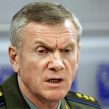
RUSSIAN TROOPS IN GEORGIA: PULLOUT, PULL-BACK, OR STAY PUT?
Publication: Eurasia Daily Monitor Volume: 5 Issue: 161
By:

Russian troops were supposed to withdraw by August 22 from all of Georgia’s interior areas. That was Russian President Dmitry Medvedev’s word to Nicolas Sarkozy, when the French president — broker of the August 12-13 armistice — telephoned Medvedev several times afterward for clarification.
Some Russian forces began moving back to Russia on August 22, but the pace and scope of the withdrawal remains unclear. Until August 21 the Russians seemed to be stalling for time. They seized some logistical nerve centers in Georgia’s interior, with the apparent intention to control the country’s transportation system. And they began carving out two “security zones” under Russian military control.
On August 19 Medvedev assured Sarkozy that “Russian troops would withdraw from Georgia’s interior to South Ossetia and to Russia by August 22, with the exception of 500 troops needed for additional security measures,” according to the Kremlin’s communiqué (Interfax, August 19). Withdrawal “to South Ossetia and to Russia ” blurs the distinction between the two destinations, hinting at Moscow’s intention to relocate some Russia-based forces to South Ossetia in violation of the armistice. The 500 “excepted” troops are almost certainly earmarked to garrison a buffer zone (“security zone”) beyond South Ossetia, in Georgia’s interior. The buffer zone scheme does not figure in the Sarkozy-brokered armistice, but was added by him on August 14-16 at Russian insistence.
The Russians also misled Sarkozy linguistically. Medvedev used the Russian word “otvod,” meaning pull-back, rather than “vyvod” for “pullout.” The French should have been alert to this deception. It had already been used by Col.-General Anatoly Nogovitsyn in his daily briefing on August 18, when Nogovitsyn announced that at least some Russian forces would do an otvod, not a vyvod, and explained the Russian linguistic nuance for the world media (Interfax, August 18). This means that Russian troops would be pulled back within Georgia, rather than out of Georgia. Oblivious or perhaps undaunted, the Elysee Palace declared, “President Medvedev announced to President Sarkozy that the withdrawal would be concluded on August 21-22, with the exception of 500 personnel charged with implementing additional security measures under article five of the August 12 agreement” (Agence France Presse, August 19).
On August 21, however, General Vladimir Boldyrev, commander of Russia’s ground forces, announced that the withdrawal of troops from Georgi ’s interior would only start on August 22 and take another 10 days thereafter (Interfax, August 21). August 22 is also the date when the Russian buffer zone scheme is expected to take effect, despite Georgian and U.S. objections.
Meanwhile, Moscow has sought pretexts for delaying the pullback/pullout of its troops. Russia’s Ministry of Foreign Affairs claimed in Soviet style, “The Georgian regime is still not prepared to give up its aggressive intentions.” According to the Minister, Sergei Lavrov, Russia is not bound by any troop-withdrawal deadline because the French-brokered armistice does not stipulate a time limit to the presence of Russian forces in Georgia (Interfax, August 19, 20, 21).
The relevant top military official, Nogovitsyn, claimed that Georgia is not fulfilling the armistice agreement’s stipulation about the return of all military forces to their pre-conflict locations. On this pretext Moscow delayed the return of its own forces to the pre-conflict locations in Russia. Both during the conflict and during the “armistice,” however, the Russians have damaged or destroyed most of Georgia’s military bases. And in a jibe at the United States, Moscow claims that the 2,000 Georgian soldiers, who were airlifted from Iraq to Georgia during the conflict, ought to return to their pre-conflict location in Iraq (Interfax, August 19, 20, 21).
Pending a pullout/pullback, the Russians control Georgia’s most critical economic and transportation junctions. From August 10 onward, they cut the country’s east-west highway and railway, blocking the highway with troops near Gori and blowing up the railway bridge near Kaspi. These actions brought both arteries to a complete standstill, isolating Georgia’s eastern and western halves from each other.
During the night of August 18-19 Russian troops seized the Black Sea harbor of Poti, which is Georgia ’s main commercial outlet to the outside world. The Russians had first forced Poti to halt operations by bombing it during the conflict, then looting it during the “armistice.” On August 19-21 Russian troops blocked road access to Poti, started building some kind of fortified obstacles, and installed mortars facing the city and harbor (Western news agencies, August 19-21).
Poti is situated 150 to 200 kilometers away from South Ossetia and has no conceivable relation to that conflict. Meanwhile the Russians are carving out two buffer zones (“security zones”) inside Georgia, one around Abkhazia and another one around South Ossetia. The zone being drawn around South Ossetia could bring Russian ground forces within 70 kilometers of Tbilisi.
On August 20, Russian troops began digging earthen berms and stringing barbed wire to demarcate that “security zone” from the rest of Georgia. On August 21 the Russian Embassy in Tbilisi notified Georgia’s Ministry of Foreign Affairs that all delegations and persons, whether coming abroad or already residing in Georgia, wishing to visit that zone, must notify Russia’s military authorities in advance about the visitors’ identities, goals, duration of the trip, and itinerary. At the moment, therefore, it may seem that an occupation regime complete with barbed-wire fence is taking shape in that “security zone” inside Georgia.
The days immediately ahead should show which Russian forces pull out, pull back, or stay put.




